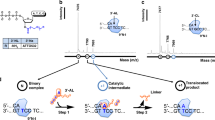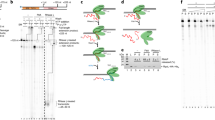Summary
The DNA sequences of the diadenosine tetraphosphatase gene (apaH) and of the flanking regions were determined. Three other genes were identified in the flanking regions: ksgA, apaG and folA encoding, respectively, a 16 S rRNA methyltransferase, an unidentified protein of Mr 13,826 and dihydrofolate reductase, with the order folA-apaH-apaG-ksgA. The apaH gene is thus located between folA and ksgA at 1 min on the Escherichia coli chromosome linkage map and folA is transcribed clockwise, whereas ksgA, apaG and apaH are transcribed in the opposite direction. It was shown that ksgA, apaG and apaH can be expressed from a polycistronic mRNA originating from a promoter (p1) located upstream of ksgA. However, another promoter (p2) was found within the ksgA structural gene. This promoter, active in vivo, can account for p1-independent expression of the two distal cistrons, apaG and apaH. Finally, the effect on diadenosine tetraphosphatase over-production of a frameshift mutation causing premature translational termination of apaG suggests that expression of apaG and apaH is coupled at the translational level.
Similar content being viewed by others
References
Andresson OS, Davies JE (1980) Genetic organization and restriction enzyme cleavage map of the ksgA-pdxA region of the Escherichia coli chromosome. Mol Gen Genet 179:211–216
Bachmann BJ (1983) Linkage map of Escherichia coli K-12, edition 7. Microbiol Rev 47:180–230
Birnboim HL, Doly J (1979) A rapid alkaline extraction procedure for screening recombinant plasmid DNA. Nucleic Acids Res 7:1513–1523
Blanquet S, Plateau P, Brevet A (1983) The role of zinc in 5′, 5′-diadenosine tetraphosphate production by aminoacyl-transfer RNA synthetases. Mol Cell Biochem 52:3–11
Bochner BR, Lee PC, Wilson SW, Cutler CW, Ames BN (1984) AppppA and related adenylylated nucleotides are synthesized as a consequence of oxidation stress. Cell 37:225–237
Bolivar F, Rodriguez RC, Greene PJ, Betlach MC, Heyneker HL, Boyer J (1977) Construction and characterization of new cloning vehicles. II. A multipurpose cloning system. Gene 2:95–113
Boyer HW, Roulland-Dussoix D (1969) A complementation analysis of the restriction and modification of DNA in E. coli. J Mol Biol 41:459–472
Brevet A, Plateau P, Best-Belpomme M, Blanquet S (1985) Variation of Ap4A and other dinucleoside polyphosphates in stressed Drosophila cells. J Biol Chem 260:15566–15570
Brosius J (1984) Plasmid vectors for the selection of promoters. Gene 27:161–172
Carter P, Bedouelle H, Winter G (1985) Improved oligonucleotide site-directed mutagenesis using M13 vectors. Nucleic Acids Res 13:4431–4443
Casadaban MJ, Chou J, Cohen SN (1980) In vitro gene fusions that join an enzymatically active β-galactosidase segment to amino-terminal fragments of exogenous proteins: Escherichia coli plasmid vectors for the detection and cloning of translational initiation signals. J Bacteriol 143:971–980
Coulondre C, Miller JH (1977) Genetic studies of the lac repressor. III. Additional correlation of mutational sites with specific amino acid residues. J Mol Biol 117:525–575
Garrison PN, Barnes LD (1984) Assay of adenosine 5′,P1-tetraphospho-P4-5‴-adenosine and adenosine 5′-P1-tetraphospho-P4-5‴-guanosine in Physarum polycephalum and other eucaryotes. J Biochem 217:805–811
Gren EJ (1984) Recognition of messenger RNA during translational initiation in Escherichia coli. Biochimie 66:1–29
Grummt F (1983) Diadenosine tetraphosphate (Ap4A): a putative chemical messenger of cell proliferation control and inducer of DNA replication. Plant Mol Biol 2:41–44
Guranowski A, Jakubowski H, Holler E (1983) Catabolism of diadenosine 5′,5‴-P1, P4-tetraphosphate in procaryotes. J Biol Chem 258:14784–14789
Lee PC, Bochner BR, Ames BN (1983a) Diadenosine 5′,5‴-P1, P4-tetraphosphate and related adenynylated nucleotides in Salmonella typhimurium. J Biol Chem 258:6827–6834
Lee PC, Bochner BR, Ames BN (1983b) AppppA, heat-shock stress, and cell oxidation. Proc Natl Acad Sci USA 80:7496–7500
Lottspeich F (1985) Microscale isocratic separation of phenylthiohydantoin amino acid derivatives. J Chromatogr 326:321–327
Lupski JR, Altaba Ruiz A, Nigel Godson G (1984) Promotion, termination, and anti-termination in the rpsU-dnaG-rpoD macromolecular synthesis operon of E. coli K-12. Mol Gen Genet 195:391–401
Maniatis T, Fritsch EF, Sambrook J (1982) Molecular cloning: A laboratory manual. Cold Spring Harbor Laboratory, Cold Spring Harbor, New York
Maxam M, Gilbert W (1980) Sequencing end-labeled DNA with base-specific chemical cleavages. Methods Enzymol 65:499–550
McLennan AG, Prescott M (1984) Diadenosine 5′,5‴-P1,P4-tetraphosphate in developing embryos of Artemia. Nucleic Acids Res 12:1609–1617
Méchulam Y, Fromant M, Mellot P, Plateau P, Blanchin-Roland S, Fayat G, Blanquet S (1985) Molecular cloning of the E. coli gene for diadenosine 5′,5‴-P1,P4-tetraphosphate pyrophosphohydrolase. J Bacteriol 164:63–69
Messing J (1983) New M13 vectors for cloning. Methods Enzymol 101:20–78
Messing J, Gronenborn B, Muller-Hill B, Hofschneider PH (1977) Filamentous coliphage M13 as a cloning vehicle: insertions of a HindII fragment of the lac regulatory region in M13 replicative form in vitro. Proc Natl Acad Sci USA 74:3642–3646
Miller JH (1972) Experiments in molecular genetics. Cold Spring Harbor Laboratory, Cold Spring Harbor, New York
Plateau P, Fromant M, Brevet A, Gesquiere A, Blanquet S (1985) Catabolism of bis-(5′ nucleosidyl) oligophosphates in Escherichia coli: metal requirements and substrate specificity of homogenous diadenosine 5′,5‴-P1,P4-tetraphosphate pyrophosphohydrolase. Biochemistry 24:914–922
Rosenberg M, Court D (1979) Regulatory sequences involved in the promotion and termination of RNA transcription. Annu Rev Genet 13:319–353
Sancar A, Wharton RP, Seltzer S, Kacinski BM, Clarke ND, Rupp WD (1981) Identification of the uvrA gene product. J Mol Biol 148:45–62
Sanger F, Coulson AR, Barell BG, Smith AJH, Roe B (1980) Cloning in single-stranded bacteriophage as an aid to rapid DNA sequencing. J Mol Biol 143:161–172
Schmitter JM, Méchulam Y, Fayat G, Anselme M (1986) Rapid purification of DNA fragments by high performance size exclusion chromatography. J Chromatogr 378:462–466
Schumperli D, McKenney K, Sobieski DA, Rosenberg M (1982) Translational coupling at an intercistronic boundary of the Escherichia coli galactose operon. Cell 30:865–871
Shine J, Dalgarno L (1974) The 3′-terminal sequence of E. coli 16 S ribosomal RNA: complementarity to nonsense triplets and ribosome binding sites. Proc Natl Acad Sci USA 71:1342–1346
Smith DR, Calvo JM (1980) Nucleotide sequence of the E. coli gene coding for dihydrofolate reductase. Nucleic Acids Res 8:2255–2274
Sparling PF, Ikeya Y, Elliot D (1973) Two genetic loci for resistance to kasugamycin in Escherichia coli. J Bacteriol 113:704–710
Stern MJ, Ames GF-L, Smith NH, Robison EC, Higgins CF (1984) Repetitive extragenic palindromic sequences: a major component of the bacterial genome. Cell 37:1015–1026
Sutcliffe JG (1978) Nucleotide sequence of the ampicillin resistance gene of Escherichia coli plasmid pBR322. Proc Natl Acad Sci USA 75:3737–3741
Van Buul CPJJ, Van Knippenberg PH (1985) Nucleotide sequence of the ksgA gene of Escherichia coli: comparison of methyltransferases effecting dimethylation of adenosine in ribosomal RNA. Gene 38:65–72
Yanisch-Perron C, Vieira J, Messing J (1985) Improved M13 cloning vectors and host strains: nucleotide sequences of the M13mp18 and pUC19 vectors. Gene 33:103–119
Zamecnick P (1983) Diadenosine 5′,5‴-P1,P4-tetraphosphate (Ap4A):its role in cellular metabolism. Anal Biochem 134:1–10
Author information
Authors and Affiliations
Additional information
Communicated by A Böck
Rights and permissions
About this article
Cite this article
Blanchin-Roland, S., Blanquet, S., Schmitter, JM. et al. The gene for Escherichia coli diadenosine tetraphosphatase is located immediately clockwise to folA and forms an operon with ksgA . Mol Gen Genet 205, 515–522 (1986). https://doi.org/10.1007/BF00338091
Received:
Issue Date:
DOI: https://doi.org/10.1007/BF00338091




